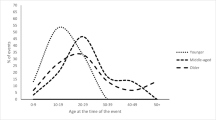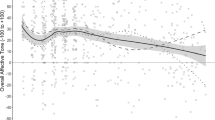Abstract
Though autobiographical remembering is a common means of emotional expression in everyday life, rarely have autobiographical narratives been used to assess emotion. Studies rely instead on retrospective scalar measures. In this study, 87 young (M = 20) and older (M = 62) adults' scalar reports and narratives of the salience, frequency, and intensity of emotional reactions to the OJ Simpson verdict announcement were compared. Scalar measures and autobiographical narratives sometimes tell different stories about certain aspects of emotion. Supporting theory, scalars measures, and narratives both indicate greater salience of emotion in late life. In contrast to expectation, older adults more frequently expressed negative affect in their narratives, but not in scalars measures. Both types of measures did, however, show a higher intensity of sadness in older adults. Theories of emotion and aging may benefit from incorporating the role of memory, and reactions to specific negative life events.
Similar content being viewed by others
REFERENCES
Averill, J. R., Ekman, P., Panksepp, J., Scherer, K. R., Shweder, R. A., & Davidson, R. J. (1994). Are there basic emotions? In P. Ekman & R. J. Davidson (Eds.), The nature of emotion: Fundamental questions. Series in affective science (pp. 5–47). New York: Oxford University Press.
Baker-Brown, G., Ballard, E. J., Bluck, S., de Vries, B., Suedfeld, P., & Tetlock, P. E. (1992). The conceptual/integrative com-plexity scoring manual. In C. P. Smith (Ed.), Motivation and personality: Handbook of thematic content analysis (pp. 401–418). Cambridge: Cambridge University Press.
Barrick, A. L., Hutchinson, R. L., & Deckers, L. H. (1989). Age effects on positive and negative emotions. Journal of Social Behavior and Personality, 4 ,421–429.
Blanchard-Fields, F., & Camp, C. J. (1990). Affect, individual differences, and real world problem solving across the adult life span. In T. M. Hess (Ed.), Aging and cognition: Knowledge organiza-tion and utilization. Advances in psychology, 71 (pp. 461–497). Amsterdam: North-Holland.
Bluck, S., Levine, L. J., & Laulhere, T. M. (1999). Autobiographical remembering and hypermnesia: A comparison of older and younger adults. Psychology and Aging, 14 ,671–682.
Bluck, S., & Li, K. Z. H. (2001). Predicting memory complete-ness and accuracy: Emotion and exposure in repeated autobi-ographical recall. Applied Cognitive Psychology, 15 ,145–158.
Brandstadter, J., & Greve, W. (1994). The aging self: Stabilizing and protective processes. Developmental Review, 14 ,52–80.
Carstensen, L. L. (1992). Social and emotional patterns in adult-hood: Support for socioemotional selectivity theory. Psychology and Aging, 7 ,331–338.
Carstensen, L. L. (1995). Evidence for a life-span theory of so-cioemotional selectivity. Current Directions in Psychological Science, 4 ,151–156.
Carstensen, L. L., Gottman, J. M., & Levenson, R. W. (1995). Emotional behavior in long-term marriage. Psychology and Aging, 10 ,140–149.
Carstensen, L. L., Pasupathi, M., Mayr, U., & Nesselroade, J. R. (2000). Emotions in everyday life across the adult life span. Journal of Personality and Social Psychology, 79 ,644–655.
Carstensen, L. L., & Turk-Charles, S. (1994). The salience of emotion across the adult life span. Psychology and Aging, 9 ,259–264.
Charles, S. T., Reynolds, C. A., & Gatz, M. (2001). Age related differences and change in positive and negative affect over 23 years. Journal of Personality and Social Psychology, 80 ,136–151.
Cohen, G. (1998). Aging and autobiographical memory. In C. P. Thompson, D. J. Herrmann, D. Bruce, J. D. Read, D. G. Payne, & M. P. Toglia (Eds.), Autobiographical memory: Theoretical and applied perspectives (pp. 105–123). New Jersey: Lawrence Erlbaum.
Cohen, G., & Faulkner, D. (1988). Life span changes in autobio-graphical memory. In M. M. Gruneberg, P. E. Morris, & R. N. Sykes (Eds.), Practical aspects of memory: Current research and issues (Vol. 1, pp. 277–282). Chichester, England: Wiley.
Diener, E., Sandvik, E., & Larsen, R. J. (1985). Age and sex effects for emotional intensity. Developmental Psychology, 21 ,590–599.
Dougherty, L. M., Abe, J. A., & Izard, C. E. (1996). Differential emotions theory and emotional development in adulthood. In C. Magi & S. H. McFadden (Eds.), Handbook of emotion, adult development, and aging (pp. 27–41). New York: Academic Press.
Erikson, E. H. (1980). Identity and the life cycle. New York: W.W. Norton & Company.
Frijda, N. H. (1987). Emotion, cognitive structure, and action tendency. Cognition and Emotion, 1 ,115–143.
Gross, J. J. (1999). Emotion regulation: Past, present, future. Cognition and Emotion, 13 ,551–573.
Gross, J. J., Carstensen, L. L., Pasupathi, M., Tsai, J., Skorpen, C., & Hsu, A. Y. C. (1997). Emotion and aging: Experience, ex-pression, and control. Psychology and Aging, 12 ,590–599
Hashtroudi, S., Johnson, M. K., & Chrosniak, L. D. (1990). Aging and qualitative characteristics of memories for perceived and imagined complex events. Psychology and Aging, 5 ,119–126.
Isaacowitz, D. M., Charles, S. T., & Carstensen, L. L. (2000). Emotion and cognition. In F. I. M. Craik & T. A. Salthouse (Eds.), The handbook of aging and cognition.Mahwah, NJ: Lawrence Erlbaum.
Knight, B. G., Gatz, M., Heller, K., & Bengtson, V. L. (2000). Age and emotional response to the Northridge earthquake: A longitudinal analysis. Psychology and Aging, 15 ,627–634.
Kovach, C. R. (1995). A qualitative look at reminiscing: Using the autobiographical memory coding tool. In B. K. Haight & J. D. Webster (Eds.), The art and science of reminiscing: Theory, re-search, methods, and applications (pp. 103–122). Washington, DC: Taylor and Francis.
Kunzmann, U., Little, T. D., & Smith, J. (2001). Is age-related sta-bility of subjective well-being a paradox? Cross-section and longitudinal evidence from the Berlin Aging Study. Psychology and Aging, 15 ,511–526.
Labouvie-Vief, G. (1997). Cognitive-emotional integration in adulthood. In K. W. Schaie & M. P. Lawton (Eds.), Annual review of gerontology and geriatrics (Vol. 17, pp. 206–237). New York: Springer.
Labouvie-Vief, G., & DeVoe, M. (1991). Emotional regulation in adulthood and later life: A developmental view. Annual Review of Gerontology and Geriatrics, 11 ,172–194.
Labouvie-Vief, G., DeVoe, M., & Bulka, D. (1989). Speaking about feelings: Conceptions of emotion across the life span. Psychology and Aging, 4 ,425–437.
Labouvie-Vief, G., Hakim-Larson, J., DeVoe, M., & Schoeberlein, S. (1989). Emotions and self-regulation: A lifespan view. Human Development, 32 ,279–299.
Lawton, M. P. (2001). Emotion in later life. Current Directions in Psychological Science, 10 ,120–123.
Lawton, M. P., Kleban, M. H., & Dean, J. (1993). Affect and age: Cross-sectional comparisons of structure and prevalence. Psychology and Aging, 8 ,165–175.
Lawton, M. P., Kleban, M. H., Rajagopal, D., & Dean, J. (1992). The dimensions of affective experience in three age groups. Psychology and Aging, 7 ,171–184.
Levenson, R. W. (2000). Expressive, physiological, and subjective changes in emotion across adulthood. In S. H. Qualls & N. Ables (Eds.), Psychology and the aging revolution: How we adapt to longer life (pp. 123–140). Washington, DC: American Psychological Association.
Levenson, R. W., Carstensen, L. L., Friesen, W. V., & Ekman, P. (1991). Emotion, physiology, and expression in old age. Psychology and Aging, 6 ,28–35.
Levine, L. J. (1996). The anatomy of disappointment: Anaturalistic test of appraisal models of sadness, anger, and hope. Cognition and Emotion, 10 ,337–359.
Levine, L. J. (1997). Reconstructing memory for emotions. Journal of Experimental Psychology: General, 126 ,165–177.
Levine, L. J., & Bluck, S. (1997). Experienced and remembered emotional intensity in older adults. Psychology and Aging, 12 ,514–523.
Levine, L. J., & Bluck, S. (2004). Painting with broad strokes: Hap-piness and the malleability of event memory. Cognition and Emotion, 18 ,559–574.
Magai, C. (2001). Emotions over the life span. In J. E. Birren & K. W. Schaie (Eds.), Handbook of the psychology of aging (pp. 399–426). New York: Academic Press.
Malatesta, C. Z., & Kalnok, M. (1984). Emotional experience in younger and older adults. Journal of Gerontology, 39 ,301–308.
Mroczek, D. K., & Kolarz, C. M. (1998). The effect of age on posi-tive and negative affect: Adevelopmental perspective on happiness. Journal of Personality and Social Psychology, 75 ,1333–1349.
Oatley, K., & Johnson-Laird, P. N. (1987). Toward a cognitive theory of emotions. Cognition and Emotion, 1 ,29–50.
Pasupathi, M. (2003). Emotion regulation as a function of social remembering: Differences between emotions elicited during an event and emotions elicited when talking about it. Memory, 11 ,151–163.
Pasupathi, M., & Carstensen, L. L. (2002). Age and emotional ex-perience during mutual reminiscing. Psychology and Aging, 18 ,430–442.
Rime, B., Finkenauer, C., Luminet, O., Zech, E., & Phillipot, P. (1998). Social sharing of emotion: Newevidence and questions. European Review of Social Psychology, 9 ,145–189.
Smith, C. A., & Lazarus, R. S. (1993). Appraisal components, core relational themes, and the emotions. Cognition and Emotion, 7 ,233–269.
Stacey, C. A., & Gatz, M. (1991). Cross-sectional age differences and longitudinal change on the Bradburn Affect Balance Scale. Journal of Gerontology: Psychological Science, 46 ,76–78.
Stein, N. L., & Levine, L. J. (1990). Making sense out of emotion: The representation and use of goal-structured knowledge. In N. L. Stein, B. Leventhal, & T. Trabasso (Eds.), Psychological and biological approaches to emotion (pp. 45–73). Hillsdale, NJ: Lawrence Erlbaum.
Strongman, K. T., & Kemp, S. (1991). Autobiographical memory for emotion. Bulletin of the Psychonomic Society, 29 ,195–198.
Wechsler, D. (1981). Manual for the Wechsler Adult Intelligence Scale-Revised. New York: Psychological Corporation.
Author information
Authors and Affiliations
Rights and permissions
About this article
Cite this article
Alea, N., Bluck, S. & Semegon, A.B. Young and Older Adults' Expression of Emotional Experience: Do Autobiographical Narratives Tell a Different Story?. Journal of Adult Development 11, 235–250 (2004). https://doi.org/10.1023/B:JADE.0000044527.52470.5d
Issue Date:
DOI: https://doi.org/10.1023/B:JADE.0000044527.52470.5d




